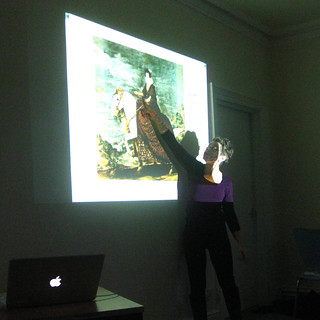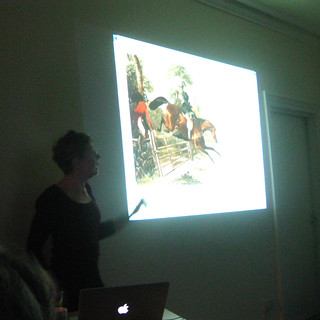We were sitting comfortably Ma'am: The truth about the side saddle revealed at Stroud Green and Harringay Library
A picture of Che Guevara was not exactly what the audience was expecting as we took our seats for a talk by Lydia Rivlin on the history of riding side saddle. It certainly intrigued us. So what was the connection?
Lydia explained that, just as the iconic portrait of Che, as well as being an historical document of what he looked like, was also recognised as a symbol of something more profound, so the use and representation of the side saddle in European history is also deeply symbolic. Today we view the side saddle through the distorted lens of a Victorian view of history, especially women's history, which fuels our expectations of seeing it in every historical re-enactment and costume drama. However, as Lydia demonstrated, if you make every European woman who appears on a horse in a costume drama ride aside, you may as well have her drive around in a Ferrari, it would be just as historically accurate.
To begin, Lydia took us back to Greek myth, where representations of women riding aside demonstrated the mythical, magical, uncontrollable nature of the goddesses, steering us through to early Christian images of real women riding on special saddles but evoking earlier pagan ideas of fertility goddesses. Coming into the Middle Ages, riding aside was largely for those who through age or ill health were unable to sit astride a horse. Aristocratic and royal women were rarely portrayed riding side saddle, nor is there evidence that it was expected of them.
It is only as we entered the early 19th century that the pragmatic nature of the side saddle changed and became, as Lydia put it, a prison. Design which previously had enabled people now became restriction and women who wished to ride astride were viewed as sexually suspect. Lydia, who rides side saddle frequently, said that she would have been afraid to mount a horse using the side saddles after the early modern era and before the 1830s.
Design, which has previously imprisoned women, fortunately came to the rescue in the form of the leaping head, which allowed women to jump horses and to compete on a level playing field with men. This picture of Georgina Charlotte Theobold that Lydia is using as illustration is one of the first depictions of a woman as an athlete, since the Classical Era that depicted warrior goddesses in their art.
Side saddles in the modern age, Lydia contends are now about choice and a wish to be elegant, but also to show off skill and riding prowess. Lydia is pictured below demonstrating just that.
Entirely based on a wide variety of primary sources, Lydia's talk was challenging, entertaining and well put together, covering design, art history and social history. The audience stayed to ask questions and discuss Lydia's propositions and I certainly felt when I left that I had my misconceptions well and truly corrected. Should she be persuaded to deliver it again in Haringey, I would strongly recommend that you go along.
Of course, now I'm going to be sitting watching historical dramas muttering about inaccuracy even more than I do already.
Lydia's talk was part of an ongoing programme of free talks organised by The Friends of Stroud Green and Harringay Library on a wide variety of topics designed to entertain and enlighten. We have been delighted to welcome speakers on topics ranging from alliums to Lotus cars.
If you have a subject you'd like to give a talk on a Saturday afternoon in 2013, please let me know or talk to Vicky at the library next time you're passing.
Tags for Forum Posts: Friends of Stroud Green and Harringay Library, stroud green and harringay library, talks
Replies to This Discussion
-
I wish I had been able to attend this - I did some side-saddle riding when I was younger but never really thought much about the history of why and when it came about! Nice to read the write up though, thank you!
-
The book "If wishes were horses" by Susanna Forrest is worth reading- it is part memoir about her re-learning to ride as an adult and part musing on the relationship with horses including a lot about the history of women and side saddles.
-
That sounds like a great book. will keep an eye out for it! thanks :-)
-
Yes agree. Lydia's was a great talk.I hadn't expected it would begin in ancient Greece. There is more to the side saddle than meets the eye; if anyone missed the talk this time, I hope Lydia might do it again.
-
Amazing. Thanks for posting.
© 2025 Created by Hugh.
Powered by
![]()

